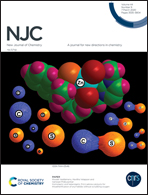BaTiO3 nanoparticle-decorated hierarchical Ni nanowire assemblies for magnetoelectric applications†
Abstract
One dimensional multiferroic systems with spin-charge coupling at room temperature are highly useful in future multifunctional devices. A facile protocol was used to process one dimensional multiferroic heterostructures of Ni–BaTiO3 (Ni@BTO) by adopting the wet chemical reduction of hierarchical Ni nanowires, followed by controlled addition of barium titanate nanoparticles. The magnetic and electric properties of hierarchical Ni nanowires decorated with BaTiO3 (BTO) nanoparticles suggest that their magnetic and electric transport mechanisms are influenced by ferroelectric BaTiO3 coating. The surface between the prickles in the hierarchical Ni nanowires is visibly covered with BTO nanoparticles, forming a partial core–shell magnetoelectric system. In the typical Ni@BTO, improved coercivity was achieved and the magnetoelectric coupling coefficient of 517 μV cm−1 Oe−1 was obtained. Since ferromagnetic metals are conducting, Ni-based multiferroic composite structures were difficult to realize. Nevertheless, this is the first report on the encapsulation of nickel-based nanowires with barium titanate, where the former is synthesized without the aid of templates, external magnetic field, or pressure. Hence, the suggested protocol has the potential to develop leakage-free, tailor-made magnetoelectric nanostructures for memory applications.



 Please wait while we load your content...
Please wait while we load your content...